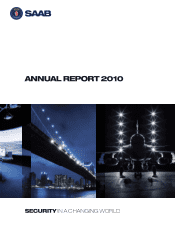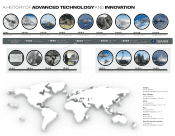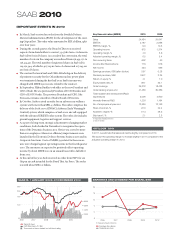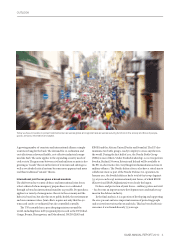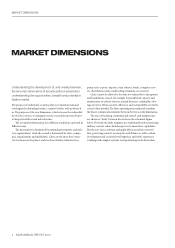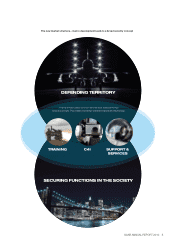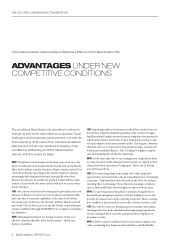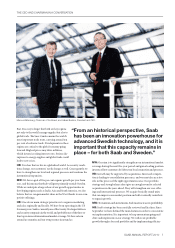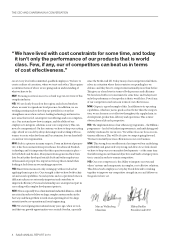Saab 2010 Annual Report Download - page 6
Download and view the complete annual report
Please find page 6 of the 2010 Saab annual report below. You can navigate through the pages in the report by either clicking on the pages listed below, or by using the keyword search tool below to find specific information within the annual report.
A growing number of countries and international alliances simply
want more bang for the buck. e demand for co-ordination and
cost eectiveness favours exible, cost-eective industrial compa-
nies like Saab. e same applies to the expanding security needs of
civil society. e gray zone between civil and military security is also
growing as “inside” threats in the form of terrorism and sabotage as
well as overloaded critical systems become more apparent and more
real than traditional “outside” threats.
International joint forces given a broad mandate
e shi toward net-centric defence and international joint forces
is best achieved when emergency preparedness is co-ordinated
through as broad an international mandate as possible. Preparedness
applies to a variety of emergencies: threats to the economy and the
hubs it is based on, but also threats to public health, the environment
and our common values. Joint eorts require not only that the sys-
tems used can be co-ordinated, but also controlled centrally.
e UN currently has peacekeeping missions around the
world, including those led by regional players such as the EU (Chad,
Congo, Bosnia, Herzegovina, and Macedonia), NATO (ISAF and
KFOR) and the African Union (Darfur and Somalia). e EU also
maintains two battle groups, ready to deploy to crises anywhere in
the world. During the rst half of , the Nordic Battle Group
(NBG) is one of them. Under Swedish leadership, , troops from
Sweden, Finland, Norway, Estonia and Ireland will be available to
the EU on short notice for everything from humanitarian actions to
military oenses. e Nordic defence forces also have a stated aim to
collaborate more as part of the Nordic Defence Co-operation. In
January , the Swedish defence had a total of troops (against
at year-end ) in international joint forces, of which KFOR
(Kosovo) and ISAF (Afghanistan) were clearly the largest.
Defence and protection of joint forces – military, police and civil
– has become an important new development area and market seg-
ment in the defence industry.
In the nal analysis, it is a question of developing and supporting
the ever-present and ever-important mission of protecting people
and society from various threats and risks. is has been Saab’s mis-
sion since it was founded nearly years ago.
Today we have to be able to protect national borders as well as global and regional trade as well as securing functions in the society and flows of people,
goods, services, information and capital.
SAAB ANNUAL REPORT 2010 3
OUTLOOK

